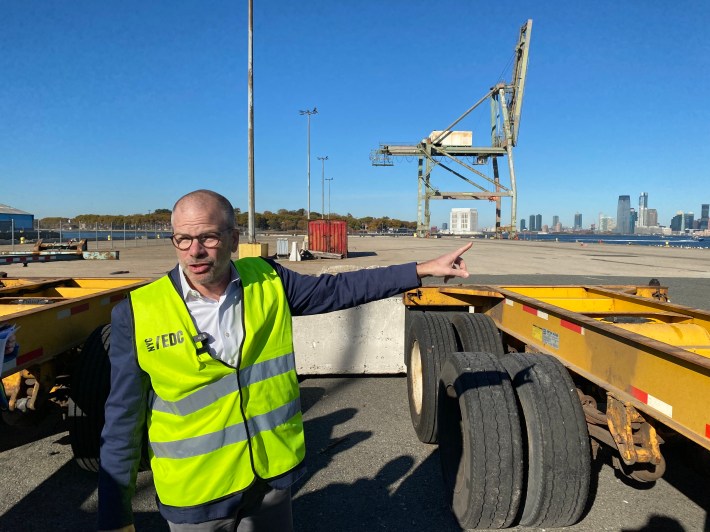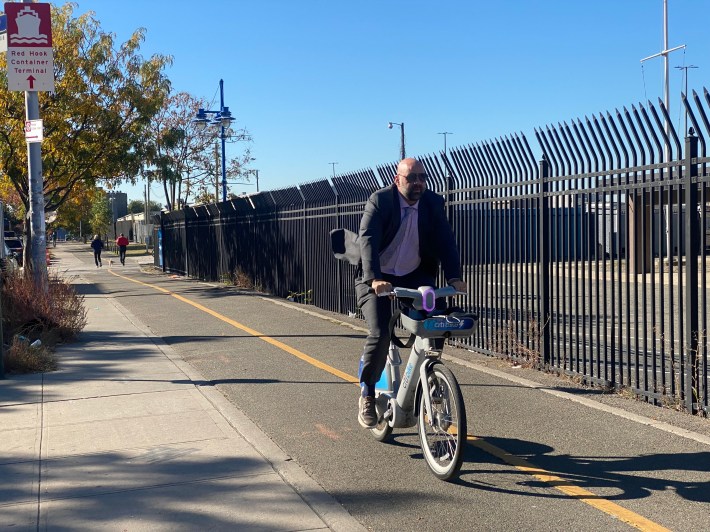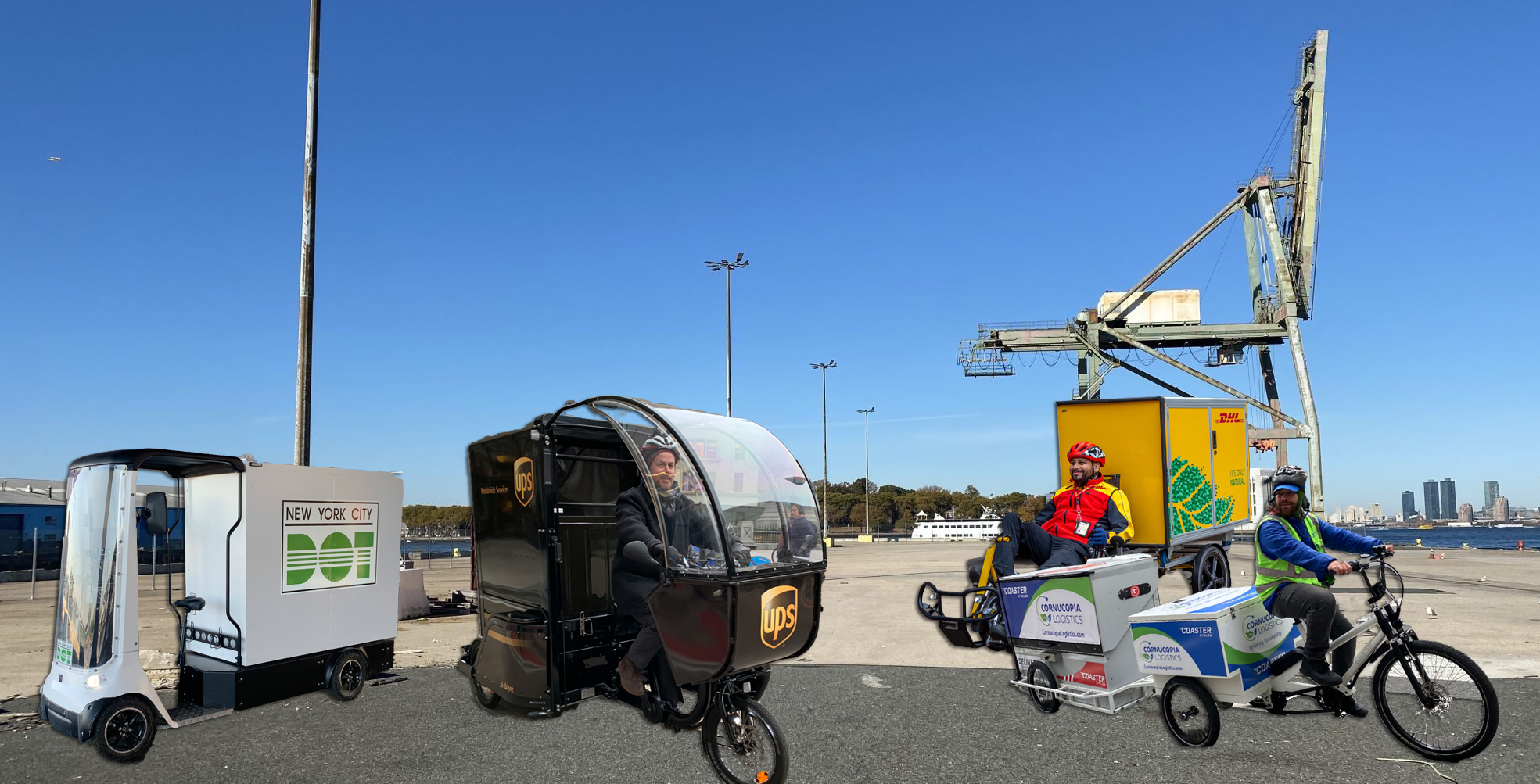Red Hook, blue highway.
A pair of disused piers at the Brooklyn waterfront could become a "key node" in the city's nascent efforts to move truck deliveries onto barges and bikes, coming online at some point in the future as part of a larger redevelopment of the Red Hook Container Terminals, according to officials.
The maritime facility along the Columbia Street Waterfront already transports tens of thousands of shipping containers across the harbor to New Jersey each year via barge, but the city's quasi-public Economic Development Corporation hopes to expand the waterborne transportation hub and move goods on land via electric cargo bikes and smaller vehicles, part of the city's effort to exploit what it calls the "blue highway."
"What [the Red Hook Container Terminal] is doing today probably gets 30,000 truck trips [annually] off the road at a minimum. That can grow substantially," said EDC's CEO Andrew Kimball during a press tour of the maritime lots on Friday.
The change could bring less heavy commercial traffic and road violence to areas plagued by trucking, such as nearby Red Hook where last-mile delivery warehouses have sprung up in recent years, causing a boom in delivery vehicles.
The streets of Red Hook have also filled up with cruise ship passengers getting into hundreds of individual Ubers and Lyfts to Manhattan anytime a massive liner docks at EDC's Atlantic Basin wharf just to the south.

It's unclear when these blue highways will become a reality at the Brooklyn waterfront and EDC is still developing its final proposal for overhauling the massive 122-acre terminals it recently took over from the Port Authority.
The coastal site is slated to become a new mixed-use complex with housing and new open spaces under the redevelopment Mayor Adams announced in May. The city will release a master plan and launch an environmental review in March. Officials hope to issue a request for proposals for future development by mid-2026, according to an EDC rep.
This city is 'nuts'
A whopping 90 percent of New York City's goods move around via gas guzzling trucks — above the national average of 70 percent.
Existing barges at the Red Hook Terminals travel across the harbor to Newark for cold storage for goods like fresh food, before such foodstuffs are loaded onto lorries in the Garden State and driven back to the five boroughs to places like the Hunts Point Produce Market.
"That’s nuts," said Kimball. "In the future, it should come in here, it should get into cold storage, it should go directly out to your final destination by e-cargo bike or electric truck, or it should get on a barge and go directly up to Hunts Point."
The city-controlled EDC is eyeing the defunct Piers 9A and 9B near Columbia Street, between Kane and Degraw streets, for the blue highway facilities. Smaller vessels would pull up and unload cargo onto electric vehicles, including e-cargo bikes and smaller vans, Kimball said.
"The idea here is you would have a new modern pier with ships that come up sideways to it. Probably this would be the area most focused on blue highway, so goods coming by barge and fast boat, going out by barge and fast boat," he said.
Adjacent Pier 10 could still serve larger vessels, the official added.
It's unclear how many heavy hauler trips the boat-to-bike regime would eliminate, but Kimball forecast that it will be "substantial."
"I don’t have an answer today about how collectively all those different pieces, how many trucks those are going to bring off the road, but it is going to be substantial, and every one percent you cut into that [90 percent] is a major improvement of quality of life for New Yorkers and for our economy." Kimball told Streetsblog during the tour.
City officials have frequently talked about transitioning more shipping of goods back to the Big Apple's waterways, but progress so far has been too little too slowly to really make a dent in the trucking dominance, experts have said.
EDC plans to retrofit six piers across the city as part of its blue highways plan, diverting some 350,000 annual miles of trucking in the city, a minuscule fraction of the what the the Trucking Association of New York says are seven billion annual truck miles on the Big Apple’s roads.
The most fleshed-out proposal yet is set to come to the Downtown Manhattan Heliport, which might not get going until 2029, according to EDC.
A beer distributor showed how blue highways could work, testing out brew deliveries from the Bronx to the Lower East Side two years ago.
EDC could also add e-cargo drop offs to its 25 NYC Ferry docks, or get creative with the roughly 100 miles it controls along the city's 550-mile shoreline, but the Marine Terminal facility offers a new major opportunity for blue highways, according to Kimball.
"We didn’t have this site before, we didn’t have this key node to work with," he said.
It's not just boats
The city will also have to reshape its streetscape outside the new transfer hubs to accommodate more and larger commercial bike traffic.
The adjacent Brooklyn Waterfront Greenway connecting Columbia Street down to Red Hook and up to Brooklyn Bridge Park already receives heavy traffic, including as a key transportation corridor for cyclists, according to a recent report.

Kimball declined to specify whether the city will widen existing bike lanes or add more to match the increase in two-wheeled traffic, but he said EDC is working with the Department of Transportation on the street-side effects.
"There are going to need to be more and more e-cargo bikes utilized for delivering that last mile to get trucks off the road," Kimball said. "How those interface with regular bicyclists, that is an issue that’s being looked at right now, how do we widen those bike lanes — absolutely critical."






